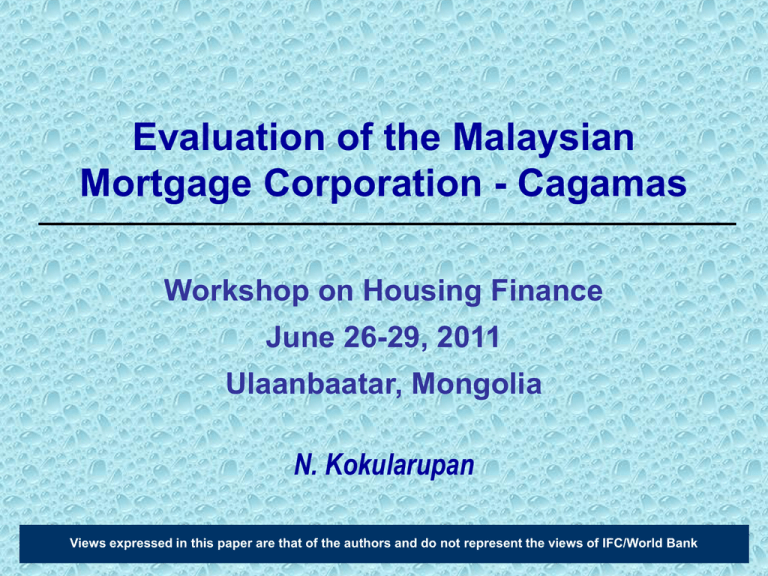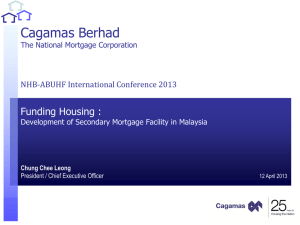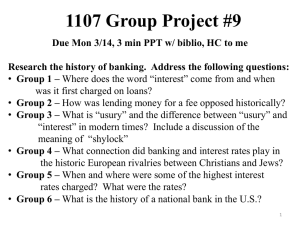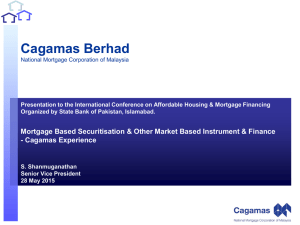Cagamas Evolving Role (Contd)
advertisement

Evaluation of the Malaysian Mortgage Corporation - Cagamas Workshop on Housing Finance June 26-29, 2011 Ulaanbaatar, Mongolia N. Kokularupan Views expressed in this paper are that of the authors and do not represent the views of IFC/World Bank Cagamas Liquidity Model Provide liquidity to mortgage originators at competitive prices to promote home ownership Develop the local capital market by being a credible issuer of high quality securities Purchase with Recourse Purchase without Recourse Conventional Cagamas Bonds, Cagamas RMBS, Cagamas Islamic bonds Liquidity Hedging Mechanism 2 Cagamas Liquidity Model • Started operations in October 1987 purchasing housing loans with recourse by • Purchase with recourse designed to suit local conditions and to overcome barriers that could prevent Scheme from taking off successfully • Interim step towards Purchase without Recourse and Securitization 3 P Purchase with Recourse with Recourse Grant loans and debts House Owners Sell loans and debts Financial Institutions and Selected Corporations Cagamas Issues debt securities Lead Managers Investors Subscribe to or purchase debt securities 4 Types of Purchase with Recourse Purchase With Recourse • Housing Loans - fixed rate (1987) - floating rate (1992) - convertible rate (1993) • Islamic house financing debts (1994) • Industrial property loans (1996) • Hire purchase (1998) and leasing debts • Islamic hire purchase debts (2002) • Credit card receivables (2003) • Islamic personal loans (2008) 5 Benefits of Purchase with Recourse • Able to source long-term funds • Hedge interest rate risk and liquidity risk • Able to price mortgage loans competitively • Proceeds from sale not subject to statutory reserve and liquidity requirements 6 Features of Purchase without Recourse • Outright sale of housing loans to Cagamas with no recourse to default risk • Cagamas rate based on cost plus basis – bond yield plus Cagamas required margin • Standardized structure and documentation • Cash purchase or settlement by Cagamas • Banks appointed as servicer for the loans 7 Purchase without Recourse/Securitization • Cagamas first introduced Purchase without Recourse to the financial institutions in 1999 • However, financial institutions did not find it an attractive product then due to following reasons: housing loans are good assets - excess liquidity in banking system - high risk-weighted capital adequacy ratio of banking system (12.5% in 1999) - default rates very low - foreclosure losses negligible • Breakthrough for Securitization/Purchase without Recourse came in April 2004 • Government of Malaysia mandated Cagamas as the vehicle to undertake securitization of the Government’s staff housing loans on a scheduled basis and over a period of time • 2004 – Securitization of Government’s staff housing loans • 2007 – Purchase without Recourse conventional mortgage loans from banks • 2008 – Purchase without Recourse Islamic mortgage loans from banks • 2009 – Purchase without Recourse conventional and Islamic hire purchase debts from banks 8 Cagamas Share of Market Loans Year Market Share % Year Market Share % 1987 1988 1989 1990 1991 1992 1993 1994 1995 1996 1997 1998 2.0 6.1 10.0 10.8 9.3 14.2 14.2 21.2 22.8 27.2 30.8 29.6 1999 2000 2001 2002 2003 2004 2005 2006 2007 2008 2009 2010 21.0 18.7 14.2 11.7 10.6 9.5 9.7 7.3 11.4 11.2 10.3 8.8 9 Key Success Factors of Cagamas • Shareholding structure and composition of Board • Support by Ministry of Finance, Securities Commission and Bank Negara Malaysia • Proceeds of sale of housing loans to Cagamas are exempt from statutory reserves and liquidity requirements (cheaper than fixed deposits) • Concessions granted to Cagamas bonds to kick start the operations • High quality assets • Strong risk management practices, particularly ALM • Proactive approach 10 Concessions given to Cagamas Issuance before 4 September 2004 Issuance after 4 September 2004 10% 20% Liquefiable assets status under the Liquidity Framework Class-1 liquefiable Class-2 liquefiable Yield slippage under the Liquidity Framework 4% 6% Mode of Primary Issuance Through Principal Dealers’ Network Book Building Holdings by insurance companies Accorded low risk asset status Accorded credit facilities status Risk weight under the Risk-Weighted Capital Ratio Framework 11 Cagamas Evolving Role 1987-1991 Start-up Phase 1992-1997 Take-off and Growth Phase 1998-2003 Diversification Phase 2004 to 2007 Securitization Phase 2007 onwards Provision of Risk Management Tools 12 Cagamas Evolving Role (Contd) 1987-1991: Start-up Phase • The newness of its operations and its limited product line contributed to its slow progress in the early stage • Client base: - Financial institutions (1987) - Government (1988) • Initially, only one product - buying on fixed rate for 5 years with recourse 13 Cagamas Evolving Role (Contd) • 1 Nov 1989, introduced 7-year Cagamas Rate - to increase the Company’s range of products offered to the market - to satisfy the market’s demand for such longer term facilities • On 24 August 1990, introduced 3-year Cagamas Rate - to cater to the demand for sale of housing loans for a period shorter than the standard 5 years • With the new facility, primary lenders can sell their housing loans to Cagamas for a period that may range from 3 to 7 years 14 Cagamas Evolving Role (Contd) • First five years - low volumes of housing loans purchased - unfamiliarity with Cagamas’ operations and the advantages of selling housing loans to Cagamas - • interest rates were declining rapidly Outstanding loans held by Cagamas (1987-91) As at end Housing Loans (RM million) 1987 407 1988 1,396 1989 2,490 1990 3,082 1991 3,060 15 Cagamas Evolving Role (Contd) 1992-1997: Take-off and Growth Phase • From 1992 - active marketing and introduction of new products • Widening of client base to include selected corporations • Extended its range of products on with recourse basis - Floating rate housing loans (1992) - Convertible rate housing loans (1993) - Islamic house financing debts (1994) - Industrial property loans (1996) 16 Cagamas Evolving Role (Contd) • Outstanding loans and debts held by Cagamas (1992-97) As at end Housing Loans RM million % Islamic House Financing Debts RM million % Industrial Property Loans RM million % Total RM million % 1992 5,345 100.0 5,345 100.0 1993 6,076 100.0 6,076 100.0 1994 9,915 99.7 29 0.3 9,944 100.0 1995 11,854 99.8 28 0.2 11,882 100.0 1996 16,086 99.7 56 0.3 16,142 100.0 1997 21,317 96.7 85 0.4 22,045 100.0 643 2.9 17 Cagamas Evolving Role (Contd) 1998-2003: Diversification Phase Purchase With Recourse • Hire purchase and leasing debts (1998) - serves as a hedging mechanism for such debts which are granted on a fixed rate basis • Islamic hire purchase debts (2002) - provides Islamic institutions with an avenue to raise fixed rate funds at low cost to hedge their fixed rate assets • Credit card receivables (2003) - allows the sellers to diversify their funding resources 18 Cagamas Evolving Role (Contd) As at end • Diversification into non-mortgage products has prevented the Company’s balance sheet from decreasing • Outstanding loans and debts held by Cagamas (1998-2003) Housing Loans RM million % Islamic House Financing Debts RM million % Industrial Property Hire Purchase and Islamic Hire Loans Leasing Debts Purchase Debts RM million % RM million % RM million % Total RM million % 1998 21,363 95.1 150 0.7 762 3.4 200 0.9 22,475 100.0 1999 17,493 86.9 120 0.6 868 4.3 1,659 8.2 20,140 100.0 2000 17,803 79.4 213 1.0 550 2.5 3,844 17.2 22,410 100.0 2001 15,309 68.8 143 0.6 377 1.7 6,437 28.9 22,266 100.0 2002 14,579 56.0 244 0.9 238 0.9 10,513 40.4 459.0 1.8 26,033 100.0 2003 15,140 55.4 345 1.3 55 0.2 11,236 41.1 563.0 2.1 27,339 100.0 19 Cagamas Evolving Role (Contd) 2004 : Securitization Phase • Purchase of housing loans on without recourse basis - introduced in March 1999 in tandem with the thrust towards asset-backed securitization • However, there was no urgency for the financial institutions to securitize their housing loans - housing loans are good quality assets - excess liquidity in the banking system - high risk-weighted capital adequacy ratio of the banking system [12.5% (1999), 13.1% (2005)] - housing loans are deemed to be high quality assets since their default rates are very low and foreclosure losses are negligible 20 Cagamas Evolving Role (Contd) • The breakthrough for the Scheme came in April 2004 when the Government of Malaysia mandated Cagamas as the vehicle to undertake the securitization of the Government’s staff housing loans (GSHL) on a scheduled basis and over a period of time 21 Cagamas Evolving Role (Contd) First Securitization Deal with the Government • 20 October 2004 - RM1,936 million of pensioners’ housing loans and the issuance of RM1,555 million in nominal value RMBS - Represents Malaysia’s first transaction, backed by residential mortgages Tenure (Years) Issue Amount (RM million) Maturity Date Coupon Rate (%) Spread over MGS (basis points) 3 5 7 10 580 340 290 345 19-Oct-2007 20-Oct-2009 20-Oct-2011 20-Oct-2014 3.70 4.30 4.95 5.50 18 26 38 45 • Attracted RM11.1 billion in book size (RM2.2 billion from offshore investors, RM8.9 billion domestic investors) • At the cut-off rates, book size remained substantial at RM10.6 billion giving an over-subscription rate of 5.6 times 22 Cagamas Evolving Role (Contd) 2007 Onwards: Provision of Risk Management Tools • Due to excess liquidity, the banks do not require a liquidity tool. Instead, with Basel II, banks were looking for risk management tools • Thus, Cagamas enhanced the Purchase with Recourse to create the Purchase without Recourse – risk management tool for banks • 2007 – Purchase without Recourse Conventional mortgage loans from banks • 2008 – Purchase without Recourse Islamic mortgage debts from banks • 2009 – Purchase without Recourse Conventional and Islamic Hire Purchase Debts from banks 23 Assets of Cagamas 2005 RM bil 2006 RM bil 2007 RM bil 2008 RM bil 2009 RM bil 2010 RM bil 11.4 0.7 3.3 8.7 0.6 3.1 9.9 2.7 2.5 5.3 8.0 2.4 4.8 2.2 4.9 3.9 1.8 12.2 8.0 - 3.9 0.5 11.4 7.7 - PWR Conventional MLs PWR Islamic MLs PWOR Conventional MLs PWOR Islamic MLs Government’s Securitization (Conventional MLs) Government’s Securitization (Islamic MLs) Sub total MLs 2.1 2.0 4.1 4.0 - - 17.5 14.4 24.5 26.3 25.9 23.5 PWR Conventional HPLs PWR Islamic HPLs PWR Islamic Personal Financing PWOR Conventional HPLs PWOR Islamic HPLs Sub total MLs 9.7 2.0 11.7 7.2 4.6 11.8 3.4 4.3 7.7 1.7 2.8 0.4 4.9 0.8 1.7 1.0 0.003 0.03 3.5 0.4 2.6 3.7 0.0008 0.03 6.7 Grand Total 29.2 26.2 32.2 31.2 29.4 30.2 24 Types of Bonds End 2010 RM Million Fixed Rate Bonds Medium Term Notes Commercial Papers Residential Mortgage Backed Securities Secured Credit Linked Notes Islamic Securities Islamic Residential Mortgage Backed Securities Total 480 9,420 35 4,115 150 10,535 3,365 ______ 28,100 25 Holders of Cagamas Group Debt Securities 2006 RM million Banking Institutions % 2007 RM million % 2008 RM million % 2009 RM million % 2010 RM million % 10,772 39.8 14,844 45.4 14,797 47.7 10,752 36.67 10,837 38.57 Insurance Companies and Investment Funds 4,976 18.4 6,246 19.1 7,298 23.5 8,336 28.43 8,281 29.47 Government Funds and Trusts 9,124 33.7 9,573 29.3 7,344 23.7 8,393 28.62 7,523 26.77 872 3.2 556 1.7 171 0.6 - - - - Non-resident Investors Individuals Other Corporations Total 1,307 4.8 1,476 27,050 100 32,695 4.5 100 - - 186 0.63 146 0.52 3 0.01 3 0.01 5.64 1,310 4.66 28,100 100 1,435 4.6 1,655 31,045 100 29,325 100 26 Total Outstanding Debt Market Securities % of total issuance outstanding Instruments Malaysian Government Securities 2006 2007 2008 2009 2010 48.8 52.5 47.7 49.7 51.0 Khazanah Bonds 2.3 1.9 1.9 2.1 2.0 Other Quasi-Government e.g. Multilaterial Development Financial Institutions 3.9 3.6 3.9 4.7 4.7 Cagamas Group Debt Securities 5.9 5.9 5.7 4.7 4.2 39.1 36.1 40.8 38.8 38.1 100.0 100.0 100.0 100.0 100.0 Private Debt Securities Total 27







